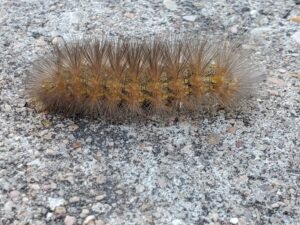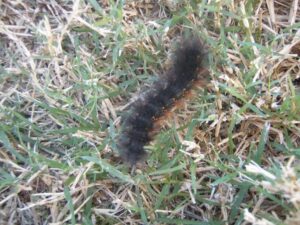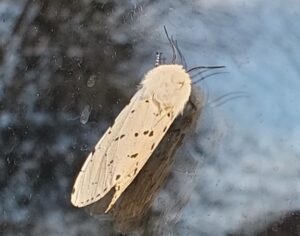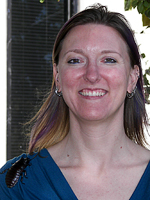Woollybear Cousins Active Now
Saltmarsh caterpillars seem to be a common sight in gardens, lawns and traveling across roads and sidewalks. These caterpillars are a particular species, Estigmene acrea, and turn into saltmarsh moths. They are often mistakenly called “woollybears” which are a different species, Pyrrharctia isabella, that turn into Isabella tiger moths. The two species are related and in the same family Erebidae.
Many Fuzzy Colors
 Saltmarsh caterpillars are extremely variable in color and have many setae in the late instar which creates a hairy or fuzzy appearance. They have striped or mottled bodies varying from black to brown to yellow and reaching lengths of 2.25 inches. Hairs, or setae, also vary in color and are mostly soft when touched. Hairs are not venomous and do not sting, but some people may be sensitive to the hairs.
Saltmarsh caterpillars are extremely variable in color and have many setae in the late instar which creates a hairy or fuzzy appearance. They have striped or mottled bodies varying from black to brown to yellow and reaching lengths of 2.25 inches. Hairs, or setae, also vary in color and are mostly soft when touched. Hairs are not venomous and do not sting, but some people may be sensitive to the hairs.
Speedy Crawlers
 Saltmarsh caterpillars actively disperse, and late instar larvae can be seen moving quickly across lawns, landscape beds, sidewalks, roads, and other locations. These caterpillars can move easily into areas and begin to feed on plants. Their chewing mouthparts cause damage to plants by defoliation. They have a wide host range feeding on numerous broadleaf plants including trees, shrubs, crops, and others.
Saltmarsh caterpillars actively disperse, and late instar larvae can be seen moving quickly across lawns, landscape beds, sidewalks, roads, and other locations. These caterpillars can move easily into areas and begin to feed on plants. Their chewing mouthparts cause damage to plants by defoliation. They have a wide host range feeding on numerous broadleaf plants including trees, shrubs, crops, and others.
Adult Moths Light Colored

Adult saltmarsh moths are medium sized and have white forewings with black dots. Hindwings are white in females and peachy yellow in males. The adult’s head and thorax are white, and abdomen is peachy yellow with black oblong spots.
Pupae occur in the soil or in leaf litter. Caterpillars spin a cocoon using silk and hairs from the body. There are multiple generations each year in Texas.
Management
Management can be as simple as removing caterpillars by hand; wear gloves while doing so. In backyard gardens, this typically is a feasible method of control. Pesticides such as Bacillus thuringiensis var. kurstaki, spinosad, or botanicals can be used against smaller stages of caterpillars (these are not as hairy as the late instars), but will not kill off late instar larvae.
For more information or help with identification, contact Wizzie Brown, Texas A&M AgriLife Extension Service Program Specialist at ebrown@ag.tamu.edu.
This work is supported in part by the Crop Protection and Pest Management, Extension Implementation Program [award no. 2021- 70006-35347/project accession no. 1027036] from the United States Department of Agriculture (USDA) National Institute of Food and Agriculture.
Additional Resources
About Wizzie

Wizzie Brown
County Extension Program Specialist – Integrated Pest Management
Email:EBrown@ag.tamu.edu
Wizzie has been with Texas A&M AgriLife Extension Service since 2002 and has been playing with insects since she was a toddler. She is an Extension Program Specialist with the Integrated Pest Management (IPM) program. Wizzie holds a B.S. in entomology from The Ohio State University and a M.S. in entomology from Texas A&M University. The integrated pest management program provides identification, biological and management information to whomever needs help. Wizzie’s research focuses on imported fire ants, including community wide fire ant management. Wizzie also is happy to provide programs to area groups on a variety of arthropod-related topics. You can find insect and other arthropod information on Wizzie’s blog.
